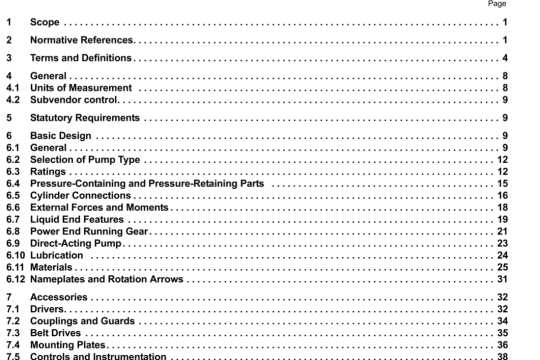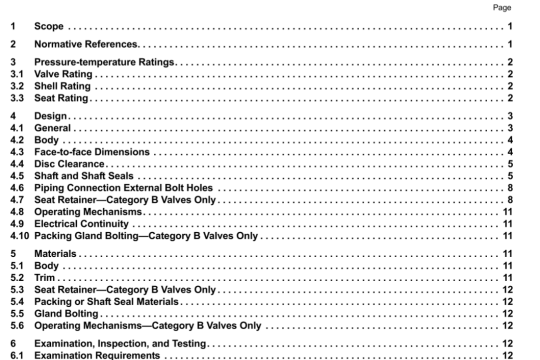API SPEC 6D:2008 pdf download
API SPEC 6D:2008 pdf download.Specification for Pipeline Valves.
The alkwable stress values shall be consistent with the selected design code or standard
If the selected design code or standard specifies a lest pressure less than 1.5 times the design pressure, then the design pressure for the body calculation shall be increased such that the hydrostatic te5t pressure in 11.3 can be applied.
NOTE 2 Some design codes or standards requwe a consistent and specific application of requirements lot fabrication and lasting. induding NDE.
7.2 Pressure and temperature rating
The nominal pressure (PN) class or the ASME rating class shall be used for the specification of the required pressure class.
Valves covered by this International Standard shall be furnished in one of the following classes:
— PN 20 (class 150); PN 50 (class 300);
— PN 64 (class 400); PN 100 (class 600);
— PN 150 (class 900); PN 250 (class 1500);
PN 420 (class 2500).
Pressure-temperature ratings for class-rated valves shall be in accordance with the applicable rating table for the appropriate material group in ASME 816.34.
Pressure-temperature ratings for PN-rated valves shall be in accordance with the applicable rating table for the appropriate material group in EN 1092-1.
If intermediate design pressures and temperatures are specified by the purchaser, the pressure-temperature rating shall be determined by linear interpolation.
Pressure-temperature ratings for valves made from matonals not covered by ASME B16.34 and EN 1092-1 shall be determined from the material properties in accordance with the applicable design standard NOTE Non-metallic parts can limit maximum pressures and minimum and maximum operating temperatures
The maximum operating pressure at the minimum and maximum operating temperatures shall be marked on the nameplate.
7.3 Sizes
Valves constructed to this International Standard shall be furnished In nominal sizes as listed In Table 1.
NOTE In this International Standard. ON sizes are slated first followed by the equivalent NPS size between brackets.
Except for reduced-opening valves, valve sizes shall be specified by the nominal sizes (DN) or nominal pipe size (NPS).
Reduced-opening valves with a circular opening shall be specified by the nominal size of the end connections and the nominal size of the reduced opening in accordance with Table 1.
10.3.2 Welding inspectors
Personnel performing visual Inspection of welding operations and completed welds shall be qualified arid certified to the requirements of AWS QCI, or equivalent, or a manufacturer’s documented training programme.
10.4 NDE of repairs
After defect removal, the excavated area shall be examined by magnetic-particle (MT) or liquid.penetrarit (PT) methods in accordance with Annex A. Repair welds on pressure-containing parts shall be examined using the same NDE method that was used to detect the defect with a minimum of MT or PT. Acceptance criteria shall be as specfied In Annex A for the appropriate product farm. The final NDE activities shall be conducted after post weld heat treatment unless otherwise agreed
The NDE requirements specified by the purchaser in 10.1 shall also apply to repair welding.
10.5 Weld end NDE
If the purchaser specifies that weld ends be subjected to volumetric or surface NDE, the examination and
acceptance criteria shall be in accordance with Clause A.22.
10.6 VIsual Inspection of castings
All castings as a minimum shall be visually inspected in accordance with MSS SP-55.
11 Pressure testing
11.1 General
Each valve shall be tested prior to shipment. The purchaser shall specify which particular supplementary tests in Annex B shall be performed
Testing shall be performed in the sequence detailed in 11.2 to 115. Pressure testing shall be carried out before coating of the valves.
If the valve has been previously tested in accordance with this International Standard, subsequent repeat testing may be performed without removal of the valve external coating.
Test fluid shall be fresh water or. by agreement, light-weight oil having a viscosity not exceeding that of water.
Water shall contain a corrosion inhibitor and, by agreement, antifreeze. The chloride content of test water in
contact with austenitic and duplex stainless steel wetted components of valves shall not exceed
30 pg!g (30 ppm by mass).
Valves shall be tested with the seating and sealing surfaces free from sealant except where the sealant is the primary means of sealing A secondary sealant system, II provided, shall not be used before or dunng tests.
Tests specified with the valve half-open may also be performed with the valve fully open, provided the body cavity is swnultaneously filled and pressurized through a cavity connection.
If valve-body connections are not available for direct monitoring, methods for monitoring pressures and/or leakage shall be determined,
Supply pressure shaM be stabilized prior to the start of pressure testing and shall be held for the minimum test durations listed in Tables 9, 10 and 11.
Pressure testing shall be performed wi accordance with documented procedures.




